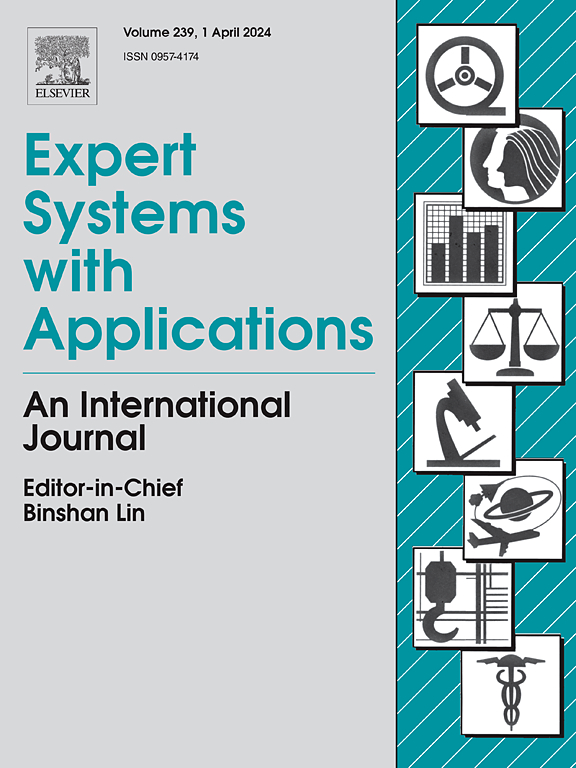基于锚点的图嵌入与软标签学习的缺失标签多标签分类
IF 7.5
1区 计算机科学
Q1 COMPUTER SCIENCE, ARTIFICIAL INTELLIGENCE
引用次数: 0
摘要
尽管在多标签学习方面取得了进展,但处理弱注释数据中的缺失标签仍然具有挑战性。基于图的方法利用样本结构信息促进语义重构来恢复缺失标签,取得了令人满意的效果。然而,现有的基于图的软标签语义重构方法仍然存在缺少标签分类学习的问题。现有方法存在两个局限性:(a)实例相似图的构建和分类任务的执行分开导致分类相似矩阵的次优;(b)一些自适应k连通图学习方法在构造k近邻相似矩阵时产生的高计算成本阻碍了它们的实际应用。此外,复杂的标签相关性进一步增加了准确预测所有可能标签的难度。本文提出了一种结合二部图和软标签学习的多标签缺失标签分类方法。首先,我们基于k-means聚类获得样本的锚点,并以锚点和原始样本作为二部图的权值,构造具有k个最近邻连通分量的稀疏二部图相似矩阵。其次,提供基于地标选择的稀疏高阶高阶标签相关学习,对缺失标签进行软标签获取;最后,结合核技术在统一框架下学习多标签分类和标签关联,解决数据的线性不可分性问题。在几个真实世界的基准多标签数据集上的实验结果表明,与最先进的方法相比,我们提出的方法具有竞争力和有效性。本文章由计算机程序翻译,如有差异,请以英文原文为准。
Anchor-based graph embedding and soft label learning for multi-label classification with missing label
Despite progress in multi-label learning, handling missing labels in weakly annotated data remains challenging. The graph-based method utilizes sample structure information to promote semantic reconstruction to recover missing labels, and it has achieved satisfactory performance. However, the existing graph-based soft label semantic reconstruction methods still have the following problems with missing label classification learning. Existing methods face two limitations: (a) the separate construction of instance similarity graphs and execution of classification tasks results in suboptimal similarity matrices for classification; (b) the high computational cost incurred by some adaptive -connected graph learning methods when constructing -nearest neighbor similarity matrices hinders their practical application. In addition, the complex label correlations further increase the difficulty of accurately predicting all possible labels. In this paper, we propose a joint bipartite graph and soft label learning for the multi-label missing label classification method. First, we obtain the anchor of the samples based on -means clustering and construct a sparse bipartite graph similarity matrix with -nearest neighbor connected components by using the anchor and the original samples as the weight of the bipartite graph. Second, sparse high-rank and high-order label correlation learning based on landmark selection is provided to obtain soft labels for the missing labels. Finally, learn multi-label classification and label correlations jointly in a unified framework with kernel techniques to solve the linear inseparability of the data. Experimental results on several real-world benchmark multi-label datasets demonstrate the competitiveness and effectiveness of our proposed method compared with the state-of-the-art approach.
求助全文
通过发布文献求助,成功后即可免费获取论文全文。
去求助
来源期刊

Expert Systems with Applications
工程技术-工程:电子与电气
CiteScore
13.80
自引率
10.60%
发文量
2045
审稿时长
8.7 months
期刊介绍:
Expert Systems With Applications is an international journal dedicated to the exchange of information on expert and intelligent systems used globally in industry, government, and universities. The journal emphasizes original papers covering the design, development, testing, implementation, and management of these systems, offering practical guidelines. It spans various sectors such as finance, engineering, marketing, law, project management, information management, medicine, and more. The journal also welcomes papers on multi-agent systems, knowledge management, neural networks, knowledge discovery, data mining, and other related areas, excluding applications to military/defense systems.
 求助内容:
求助内容: 应助结果提醒方式:
应助结果提醒方式:


